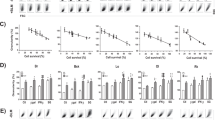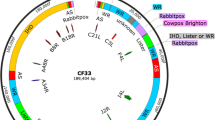Abstract
The treatment of solid tumors by retroviral delivery of the herpes simplex virus thymidine kinase (TK) followed by ganciclovir (GCV) treatment has so far shown only limited success in patients. One major drawback in this approach is the lack of efficient in vivo gene delivery to cancer cells. Although, the transduction of every single tumor cell is not a requirement since the bystander effect (BE) mediated by gap junctions allows the diffusion of the toxic GCV metabolites from TK-expressing cells toward untransduced cells. To render the TK/GCV approach more potent, and independent of the level of gap junctions, we have tested the efficiency of a TK mutant (TK30) fused to VP22, a herpes simplex protein that seems to be capable of intercellular trafficking. We failed to detect an increase in the BE with cells expressing VP22 fused to TK30 versus cells containing TK30 alone, and this result forced us to reinvestigate the trafficking properties of VP22. Using very sensitive Western blot and fluorescence assays, we were not able to detect the spread of VP22 fused either to TK30 or GFP. These results indicate that VP22 cannot be used as a cargo to translocate TK30 or GFP.
This is a preview of subscription content, access via your institution
Access options
Subscribe to this journal
Receive 12 print issues and online access
$259.00 per year
only $21.58 per issue
Buy this article
- Purchase on Springer Link
- Instant access to full article PDF
Prices may be subject to local taxes which are calculated during checkout




Similar content being viewed by others
References
Ram Z et al. Therapy of malignant brain tumors by intratumoral implantation of retroviral vector-producing cells. Nat Med 1997; 3: 1354–1361.
Harsh GR et al. Thymidine kinase activation of ganciclovir in recurrent malignant gliomas: a gene-marking and neuropathological study. J Neurosurg 2000; 92: 804–811.
Cheng YC et al. Metabolism of 9-(1,3-dihydroxy-2-propoxymethyl)guanine, a new anti-herpes virus compound, in herpes simplex virus-infected cells. J Biol Chem 1983; 258: 12460–12464.
Pitts JD . The discovery of metabolic co-operation. Bioessays 1998; 20: 1047–1051.
Moolten FL . Tumor chemosensitivity conferred by inserted herpes thymidine kinase genes: paradigm for a prospective cancer control strategy. Cancer Res 1986; 46: 5276–5281.
Bi WL, Parysek LM, Warnick R, Stambrook PJ . In vitro evidence that metabolic cooperation is responsible for the bystander effect observed with HSV tk retroviral gene therapy. Hum Gene Ther 1993; 4: 725–731.
Freeman SM et al. The ‘bystander effect’: tumor regression when a fraction of the tumor mass is genetically modified. Cancer Res 1993; 53: 5274–5283.
Culver KW et al. In vivo gene transfer with retroviral vector-producer cells for treatment of experimental brain tumors. Science 1992; 256: 1550–1552.
Caruso M et al. Regression of established macroscopic liver metastases after in situ transduction of a suicide gene. Proc Natl Acad Sci USA 1993; 90: 7024–7028.
Ram Z et al. In situ retroviral-mediated gene transfer for the treatment of brain tumors in rats. Cancer Res 1993; 53: 83–88.
Rainov NG . A phase III clinical evaluation of herpes simplex virus type 1 thymidine kinase and ganciclovir gene therapy as an adjuvant to surgical resection and radiation in adults with previously untreated glioblastoma multiforme. Hum Gene Ther 2000; 11: 2389–2401.
Cosset FL et al. High-titer packaging cells producing recombinant retroviruses resistant to human serum. J Virol 1995; 69: 7430–7436.
Sheridan PL et al. Generation of retroviral packaging and producer cell lines for large-scale vector production and clinical application: improved safety and high titer. Mol Ther 2000; 2: 262–275.
Aghi M et al. Synergistic anticancer effects of ganciclovir/thymidine kinase and 5-fluorocytosine/cytosine deaminase gene therapies. J Natl Cancer Inst 1998; 90: 370–380.
Wildner O, Blaese RM, Candotti F . Enzyme prodrug gene therapy: synergistic use of the herpes simplex virus-cellular thymidine kinase/ganciclovir system and thymidylate synthase inhibitors for the treatment of colon cancer. Cancer Res 1999; 59: 5233–5238.
Boucher PD, Ostruszka LJ, Shewach DS . Synergistic enhancement of herpes simplex virus thymidine kinase/ganciclovir-mediated cytoxicity by hydroxyurea. Cancer Res 2000; 60: 1631–1636.
Kokoris MS, Sabo P, Adman ET, Black ME . Enhancement of tumor ablation by a selected HSV-1 thymidine kinase mutant. Gene Therapy 1999; 6: 1415–1426.
Qiao J, Black ME, Caruso M . Enhanced ganciclovir killing and bystander effect of human tumor cells transduced with a retroviral vector carrying a herpes simplex virus thymidine kinase gene mutant. Hum Gene Ther 2000; 11: 1569–1576.
Black ME, Kokoris MS, Sabo P . Herpes simplex virus-1 thymidine kinase mutants created by semi-random sequence mutagenesis improve prodrug-mediated tumor cell killing. Cancer Res 2001; 61: 3022–3026.
Black ME, Newcomb TG, Wilson HM, Loeb LA . Creation of drug-specific herpes simplex virus type 1 thymidine kinase mutants for gene therapy. Proc Natl Acad Sci USA 1996; 93: 3525–3529.
Degreve B, Esnouf R, De Clercq E, Balzarini J . Selective abolishment of pyrimidine nucleoside kinase activity of herpes simplex virus type 1 thymidine kinase by mutation of alanine-167 to tyrosine. Mol Pharmacol 2000; 58: 1326–1332.
Mercer KE et al. Mutation of herpes virus thymidine kinase to generate ganciclovir-specific kinases for use in cancer gene therapies. Protein Eng 2002; 15: 903–911.
Fick J et al. The extent of heterocellular communication mediated by gap junctions is predictive of bystander tumor cytotoxicity in vitro. Proc Natl Acad Sci USA 1995; 92: 11071–11075.
Mesnil M et al. Bystander killing of cancer cells by herpes simplex virus thymidine kinase gene is mediated by connexins. Proc Natl Acad Sci USA 1996; 93: 1831–1835.
Dilber MS et al. Gap junctions promote the bystander effect of herpes simplex virus thymidine kinase in vivo. Cancer Res 1997; 57: 1523–1528.
Mesnil M, Yamasaki H . Bystander effect in herpes simplex virus-thymidine kinase/ganciclovir cancer gene therapy: role of gap-junctional intercellular communication. Cancer Res 2000; 60: 3989–3999.
Yamasaki H, Naus CC . Role of connexin genes in growth control. Carcinogenesis 1996; 17: 1199–1213.
Laird DW et al. Deficiency of connexin43 gap junctions is an independent marker for breast tumors. Cancer Res 1999; 59: 4104–4110.
Mesnil M . Connexins and cancer. Biol Cell 2002; 94: 493–500.
Park JY et al. Retinoids augment the bystander effect in vitro and in vivo in herpes simplex virus thymidine kinase/ganciclovir-mediated gene therapy. Gene Therapy 1997; 4: 909–917.
Vrionis FD et al. The bystander effect exerted by tumor cells expressing the herpes simplex virus thymidine kinase (HSVtk) gene is dependent on connexin expression and cell communication via gap junctions. Gene Therapy 1997; 4: 577–585.
Touraine RL, Vahanian N, Ramsey WJ, Blaese RM . Enhancement of the herpes simplex virus thymidine kinase/ganciclovir bystander effect and its antitumor efficacy in vivo by pharmacologic manipulation of gap junctions. Hum Gene Ther 1998; 9: 2385–2391.
Carystinos GD et al. Cyclic-AMP induction of gap junctional intercellular communication increases bystander effect in suicide gene therapy. Clin Cancer Res 1999; 5: 61–68.
Robe PA et al. Pharmacological modulation of the bystander effect in the herpes simplex virus thymidine kinase/ganciclovir gene therapy system: effects of dibutyryl adenosine 3′,5′-cyclic monophosphate, alpha-glycyrrhetinic acid, and cytosine arabinoside. Biochem Pharmacol 2000; 60: 241–249.
Matono S et al. Bystander effect in suicide gene therapy is directly proportional to the degree of gap junctional intercellular communication in esophageal cancer. Int J Oncol 2003; 23: 1309–1315.
Carrio M et al. Retrovirus-mediated transfer of the herpes simplex virus thymidine kinase and connexin26 genes in pancreatic cells results in variable efficiency on the bystander killing: implications for gene therapy. Int J Cancer 2001; 94: 81–88.
Dilber MS et al. Intercellular delivery of thymidine kinase prodrug activating enzyme by the herpes simplex virus protein, VP22. Gene Therapy 1999; 6: 12–21.
Liu CS et al. VP22 enhanced intercellular trafficking of HSV thymidine kinase reduced the level of ganciclovir needed to cause suicide cell death. J Gene Med 2001; 3: 145–152.
Elliott G, O'Hare P . Intercellular trafficking and protein delivery by a herpes virus structural protein. Cell 1997; 88: 223–233.
Phelan A, Elliott G, O'Hare P . Intercellular delivery of functional p53 by the herpes virus protein VP22. Nat Biotechnol 1998; 16: 440–443.
Wills KN et al. Intratumoral spread and increased efficacy of a p53-VP22 fusion protein expressed by a recombinant adenovirus. J Virol 2001; 75: 8733–8741.
Wybranietz WA et al. Enhanced suicide gene effect by adenoviral transduction of a VP22-cytosine deaminase (CD) fusion gene. Gene Therapy 2001; 8: 1654–1664.
Zavaglia D et al. Intercellular trafficking and enhanced in vivo antitumour activity of a non-virally delivered P27-VP22 fusion protein. Gene Therapy 2003; 10: 314–325.
Wybranietz WA et al. Quantification of VP22-GFP spread by direct fluorescence in 15 commonly used cell lines. J Gene Med 1999; 1: 265–274.
Harms JS, Ren X, Oliveira SC, Splitter GA . Distinctions between bovine herpes virus 1 and herpes simplex virus type 1 VP22 tegument protein subcellular associations. J Virol 2000; 74: 3301–3312.
Elliott G, O'Hare P . Cytoplasm-to-nucleus translocation of a herpes virus tegument protein during cell division. J Virol 2000; 74: 2131–2141.
Schwarze SR, Hruska KA, Dowdy SF . Protein transduction: unrestricted delivery into all cells? Trends Cell Biol 2000; 10: 290–295.
Falnes PO, Wesche J, Olsnes S . Ability of the Tat basic domain and VP22 to mediate cell binding, but not membrane translocation of the diphtheria toxin A-fragment. Biochemistry 2001; 40: 4349–4358.
Lundberg M, Johansson M . Is VP22 nuclear homing an artifact? Nat Biotechnol 2001; 19: 713.
Lundberg M, Johansson M . Positively charged DNA-binding proteins cause apparent cell membrane translocation. Biochem Biophys Res Commun 2002; 291: 367–371.
Leifert JA, Harkins S, Whitton JL . Full-length proteins attached to the HIV tat protein transduction domain are neither transduced between cells, nor exhibit enhanced immunogenicity. Gene Therapy 2002; 9: 1422–1428.
Richard JP et al. Cell-penetrating peptides. A reevaluation of the mechanism of cellular uptake. J Biol Chem 2003; 278: 585–590.
Lundberg M, Wikstrom S, Johansson M . Cell surface adherence and endocytosis of protein transduction domains. Mol Ther 2003; 8: 143–150.
Bennett RP, Dalby B . Protein delivery using VP22. Nat Biotechnol 2002; 20: 20.
Buchholz F et al. Different thermostabilities of FLP and Cre recombinases: implications for applied site-specific recombination. Nucleic Acids Res 1996; 24: 4256–4262.
Riviere I, Brose K, Mulligan RC . Effects of retroviral vector design on expression of human adenosine deaminase in murine bone marrow transplant recipients engrafted with genetically modified cells. Proc Natl Acad Sci USA 1995; 92: 6733–6737.
Acknowledgements
This study was supported by grants from the Canadian Institute of Health Research (IC074582) and Manuel Caruso is a Junior II Research Scholar of the Fonds de la Recherche en Santé du Québec. Vincent Roy holds a graduate student award from the MCETC/CIHR strategic training program. We are grateful to Margaret Black for providing us with TK30 and the rabbit polyclonal antibody directed against TK. We thank Nancy Roberge for the help in flow cytometry and the cell sorting.
Author information
Authors and Affiliations
Rights and permissions
About this article
Cite this article
Roy, V., Qiao, J., de Campos-Lima, P. et al. Direct evidence for the absence of intercellular trafficking of VP22 fused to GFP or to the herpes simplex virus thymidine kinase. Gene Ther 12, 169–176 (2005). https://doi.org/10.1038/sj.gt.3302394
Received:
Accepted:
Published:
Issue Date:
DOI: https://doi.org/10.1038/sj.gt.3302394
Keywords
This article is cited by
-
Fusogenic membrane glycoproteins induce syncytia formation and death in vitro and in vivo: a potential therapy agent for lung cancer
Cancer Gene Therapy (2010)
-
Mechanisms of Immunization Against Cancer Using Chimeric Antigens
Molecular Therapy (2008)
-
Evidence for Intercellular Trafficking of VP22 in Living Cells
Molecular Therapy (2007)



